Judy Middleton (2013 revised 2020)
 |
copyright © J.Middleton
There is a match being played in this old view of Sussex County Cricket Ground c. 1908 but the cricketers appear like white dots. Note the spectator watching the match for free through a gap in the hedge at the bottom left. Presumably he had excellent eyesight. |
Beginnings
In 1839 Sussex County Cricket Club was established, which makes it the oldest club in the United Kingdom as well as the first of the first class county clubs to be formed.
The early matches were played on a ground now occupied by Park Crescent, Brighton, which in those days was called officially the Royal Cricket Ground but its more prosaic name in popular usage was Brown’s.
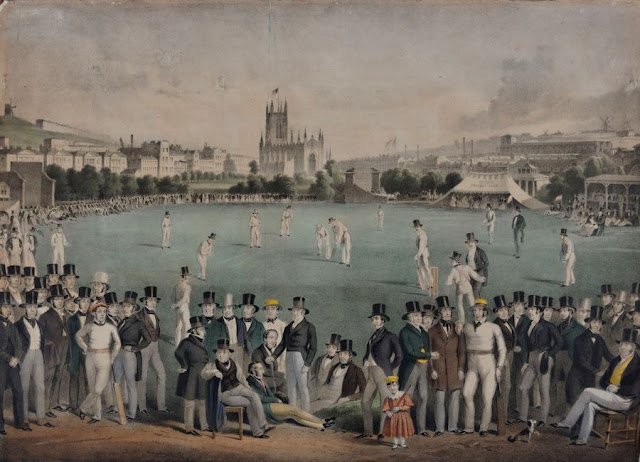 |
copyright © Royal Pavilion & Museums, Brighton & Hove
Cricket Match at Brighton between the Counties of Sussex & Kent
1849
Large colour print showing cricket match played on the Royal Cricket
Ground, (where Park Crescent is now). The tent bearing the name of Sussex
Cricket Club is to the right. Views of Brighton are shown in some detail. with
Hudson's mill on right, in
the centre distance is St Peter's Church and the houses of Pavilion
Parade and Lewes Road. The gates with lions on the top are seen with
a horse and carriage coming from Union Road. Brighton Station can
be seen to the right and the buildings to the west are shown below
it. |
Another important ground was a site now covered by Montpelier Crescent, Brighton that in 1839 went by the name of Lillywhite’s and later on acquired the romantic name of Temple Fields.
The club then found a more permanent home at the
Royal Brunswick Cricket Ground situated on Hove seafront where they remained from 1848 to 1871.
The lease on the Brunswick ground expired 1 December 1871 but fortunately a possible site for a new ground at Hove Farm had already been identified. It was around nine acres in extent and at the time was covered with a fine crop of barley; the ground also fell some 20 feet from north to south.
Edward Spary was in charge of the operation to change agricultural land into a ground fit for county cricket matches. It was not an easy task to make the land level but when everything was satisfactory the precious turf from the Royal Brunswick Ground was carefully removed and laid on the new ground, this turf being rated as having excellent qualities.
The new ground opened on Whit Monday 1872 and the first match was played between 14 Colts with William Napper as captain, versus the Gentlemen of Sussex
The first county match took place on 6 June 1872 against Gloucestershire.
Sussex County Cricket Club has been at the Eaton Road site ever since.
A concrete boundary was laid around the perimeter and a border of young trees was planted around five feet away. Unfortunately, neighbouring sheep had a fine time nibbling at the young trees and ultimately they were destroyed. It is surprising that metal guards were not used to protect the trees or indeed that new trees were not planted instead. Perhaps lack of money was the reason and certainly the club was in some difficulty in that respect.
Financial Matters
Although the cricket club had some £860 in hand from the management of the old Brunswick ground, it was not enough to cover expenses. The Stanford Estate, whose land it was, obligingly offered to loan the club £1,500; this began to be paid off in November 1874 at a rate of £150 a year until 1884 when £300 was paid. It was only after the debt had been cleared that the actual sale of the ground to the club could proceed.
Meanwhile, the club tried to organise a subscription list to enable them to purchase the land outright. But this fell through and then the subscribers wanted to know when they were getting their money back. The West Brighton Estate who would later build housing on the Royal Brunswick Cricket Ground, had contributed £100 and they too wanted an answer. But all they received was an enigmatic reply from the committee that they had been ‘somewhat hampered by the action of Lord Sheffield’. Lord Sheffield was the president of Sussex County Cricket Club.
The draft contract for the sale was drawn up in 1885 but unfortunately cricket club officials had no idea what had happened to the lease in the meantime.
There were other difficulties too and a letter-writer from 48 Wilbury Road highlighted one in his missive dated 29 October 1885. ‘One would have thought that the trustees of the Stanford Estate had made enough money out of the land in this town without imposing on the club the arrangements you speak of as to getting back the ground under certain eventualities.’
It is probable he refers to the proviso that if the land ceased to be used as a cricket ground, it would revert to the Stanford Estate, which once owned a great swathe of land running from Preston Manor down to the seafront at Hove. The Stanford Estate normally imposed a restriction on plots of land sold for building purposes and should no house have been built within seven years, then the land reverted to them.
Negotiations with the Stanford Estate were always protracted and expensive because agreements had to be approved by a judge (the heiress being of tender years) and solicitors, perhaps from two different firms, had to be paid.
Poor Mr Ashby, treasurer of Sussex County Cricket Club, acted on the assumption that the whole thing could be cut and dried for a fee of £70. But solicitors Day & Cather of Blackfriars, London, had to tell him the actual cost was £117-10-6d with the counsel’s fee being £7-19-6d. But then they had a fit of decency and agreed to accept a fee of £70 for everything.
Not quite so edifying was the tussle between Day & Cather and Verrall & Borlase, Brighton-based solicitors acting for Sussex County Cricket Club. Verrall & Borlase refused to produce an original document for Day & Cather to scrutinise under any circumstances. John Vernon of Day & Cather was so exasperated by their attitude that he wrote a long letter of protest indicating that he did not think a lesson in ABC appropriate to a man of his age and experience. He asked the firm to draw up a list of six respected gentlemen and he would chose one of them to look at the document and report back to him.
In July 1886 copies of the draft conveyance and draft mortgage were despatched and on 12 October 1886 the Old Bank, Lewes, issued a receipt for £3,500 to Verrall & Borlase.
It is not clear what sum the mortgage entailed but it is interesting to note that when the club later came into some money and wanted to pay off £1,000 of the principal sum, they were not allowed to do so. Back came a letter from Lewes dated 8 November 1886 saying the bank could not advise the trustees to accept £1,000 in reduction of the principal without notice unless of course the sanction of the court was obtained and this would probably cost more than the amount saved. However, they graciously agreed to accept the letter as six months notice of intent.
The names of the parties to the sale agreement were as follows:
Stanford Estate
John Montague Fane Benett Stanford
Cecil Porteous
Darrell Jeffreys
Trustees of Sussex County Cricket Club
Henry Campion of Danny, Hurstpierpoint
Charles Smith of Whaphams, Henfield
Mr R.A. Bevan
Mr Hardy
Mr Beard
Richard Alexander Bevan (1834-1918) is worthy of note because his family were heavily into banking for generations. He was involved in the Union Bank, Brighton, which later became Barclays. His fourth child was
Robert Polhill Bevan (1865-1925) who was born in
Brunswick Square, Hove and is now highly regarded as an artist.
The 1890s
During the 1890s there was a flurry of activity on the planning front with the architect F.T. Cawthorn submitting various plans on behalf of Sussex County Cricket Club:
1897, February – additions to the pavilion
1898, January – a new stand and players’ room
1899, December – further alterations to the pavilion
One of the men behind the provision of the players’ room was Mr H.F. Paravicini JP of 54 Third Avenue. He was still playing an active part in the club’s affairs in 1927 when he was chairman of the pavilion extension fund and again F.T. Cawthorn was asked to draw up plans.
F.T. Cawthorn
Mr F.T. Cawthorn was certainly in great demand as a local architect. The following is a list of some of his projects, besides the cricket ones mentioned above.
1902 – Church of St Agnes, Hove
1903 – detached house for Dr W.A. Bowring, north side of Furze Hill
1903 – Davigdor Road, house and shop
1903 – The Drive, detached house on east side
1904 – Davigdor Road, Garage and Motor Works
1910 –
Boundary Road / New Church Road, Barclays Bank, shops and flats
1921 –
St Nicolas Church, Portslade, oak reredos war memorial
Edwardian Times
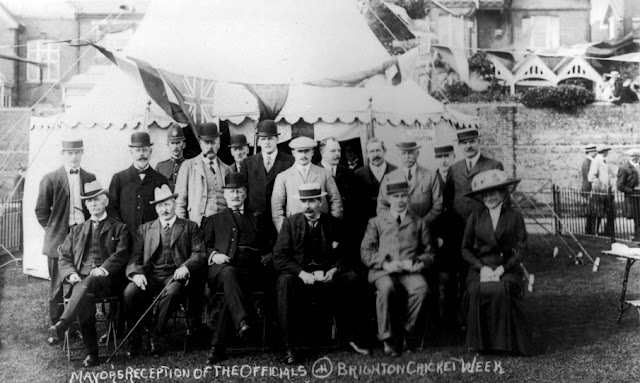 |
copyright © R. Jeeves
These officials at Brighton and Hove Cricket Week look rather stern and not all of them are looking at the camera. But the lady wearing the well-anchored hat seems more cheerful. Note the policeman at the back on the left wearing the old style jacket with high, uncomfortable collar. |
Some spectators at the county ground arrived on their bicycles and parked them behind the sightscreen. There was not much seating on offer and the few seats available were of the hard wooden variety.
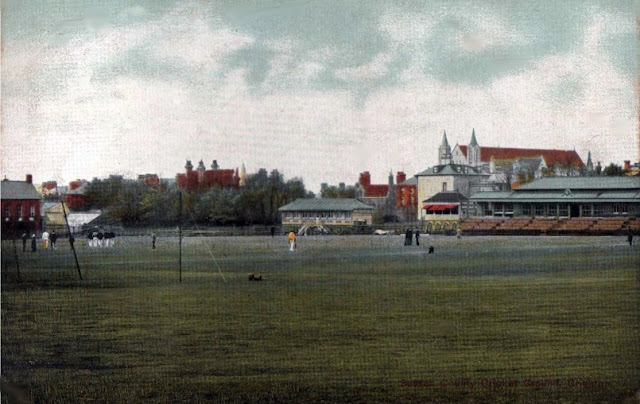 |
copyright © J.Middleton
This view was posted on 17 September 1907 and the All Saints Church is visible in the background. |
Brighton and Hove Cricket week was a social occasion because there were other entertainments besides the county matches. In 1909 you could purchase a special 12-page souvenir programme for two pence, which included photographs of the relevant cricketers from Sussex, Yorkshire and Australia. The Mayor of Hove welcomed the various cricket officials and there were refreshments in the specially erected tea tent.
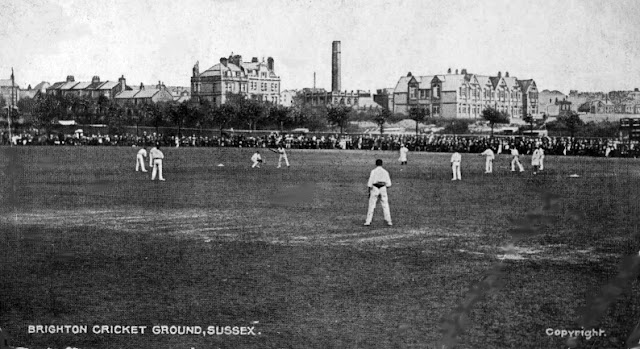 |
copyright © J.Middleton
At least you can see the cricket players in this view of 1908. Prominent in the background is the chimney completed by 1894 belonging to Hove Electricity Generating Station, which was situated on the corner of Holland Road and Davigdor Road; the coal wagons used to offload at nearby Holland Road Halt. |
North East Entrance
In 1906 the land on which this entrance was formed was purchased from Revd David Davies. The piece of land was 13 feet 3 inches wide and thus was only suitable for pedestrian access.
At that time the Sussex County Cricket Club trustees were Lord Leconfield, Earl Winterton, A.F. Somerset and David Sassoon. The Sassoon association is an interesting one. David Sassoon (1867-1929) was the son of Reuben Sassoon (1835-1905) of 7 Queen’s Gardens, Hove. Reuben, like his brother Arthur Sassoon, was a friend of the Prince of Wales, (later King Edward VII) and over the years seven Sassoon family members made their homes at Hove. David Sassoon was a patron of the arts and was always to be seen in the stalls of the Theatre Royal on an important production night; he was also a generous subscriber to charity. He enjoyed sport too and besides being a trustee of the cricket club, he was also a committee member. When the Greyhound Stadium opened at Hove he rented a £2 box, which could seat six people.
In the 1930s the cricket club discussed the possibility of a road being constructed to allow vehicular access to the county ground. But such a scheme would necessitate the purchase of an adjacent strip of land 26 feet 9 inches wide on the west side of Palmeira Avenue owned by Miss Nash. It would not, however, be a straightforward purchase. The plot was priced at £490 with additional costs of £61-19s because two sets of solicitors would be necessary and the Wick Estate would need to vary a restrictive covenant. Mr Nash had vested the land in his daughter but he became so demanding with continuous stipulations to which he added £200 for a piece of land with a 14-foot frontage to Palmeira Avenue and an 18-foot frontage to the cricket ground. At length in 1934 the committee dropped the whole idea, no doubt with a sigh of relief.
Great War
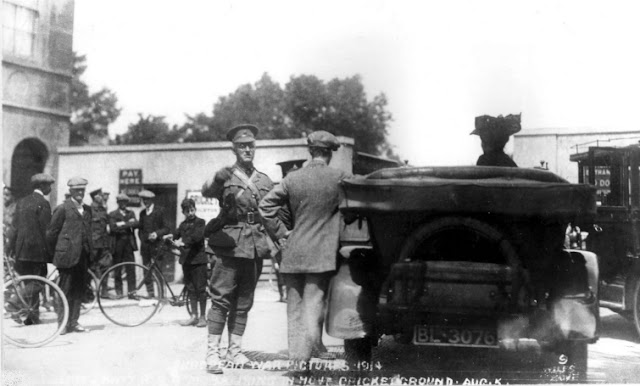 |
copyright © R. Jeeves
This evocative photograph was taken in 1914 by local man Mr Wiles and was apparently one of a series of war pictures. It shows the entrance to the county ground and the resolute soldier seems to be saying ‘You can’t park here!’ |
In 1914 Sussex County Cricket Ground was the headquarters of the 6th (Cyclist) Battalion, Royal Sussex Regiment, which was raised at Hove by Colonel C. Somers Clarke who also trained them; the battalion utilised the adjacent skating rink for drill purposes too. Advertisements were placed in London newspapers and many members of cycling clubs joined up. Eventually, the battalion consisted of eight companies, each containing 70 men plus their bicycles. It was said that the ceremonial drill at the County Ground was a sight to behold. Lieutenant Colonel F. Johnson became commanding officer and the battalion later moved to East Anglia.
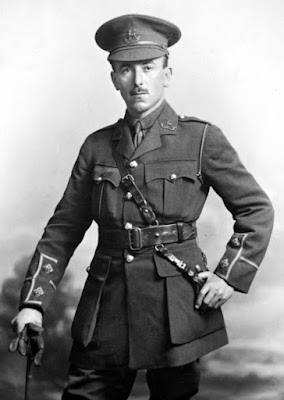 |
copyright © Brighton & Hove City Libraries
Lieutenant Francis Arthur Joseph Oddie,
previously secretary to Sussex CCC, was
killed in action at the Battle of the Somme 1916. |
In July 1915 Councillor A.R. Sargeant, Mayor of Hove, opened a miniature rifle range for the benefit of the 2
nd (Hove) Battalion of the Sussex Volunteer Training Corps at the north west corner of the county ground. Councillor Sargeant said the Mayoress would inaugurate the range by firing the first shot and for that reason he was very glad the Ambulance Corps were in attendance because he could not vouch for her accuracy. The Mayoress was handed a rifle and retaliated by scoring a bull’s eye.
In 1917 a stoolball match was staged at the county ground between the Pavilion Blues ‘damaged by wounds’ and a team of ancient lawyers ‘damaged by age’. Injured soldiers recuperating at the Royal Pavilion wore a blue uniform and every member of the stoolball team had one arm missing. The Pavilion Blues won.
In September 1918 a country fair was held at the ground and there were numerous stalls while children performed country dancing. It was part of a fund-raising campaign on behalf of Hove War Depot, which made bandages, splints and various articles of clothing for the troops and also assembled parcels of vital supplies to be sent to those held as prisoners of war. The event continued on Saturday afternoon with a baseball match between a team of Canadian artillerymen and a team from the Canadian Forestry Corps.
In July 2014 a plaque was unveiled in the Spen Cama Pavilion ‘In Memory of Sussex County Cricket Club Players and Secretary who died in two World Wars’
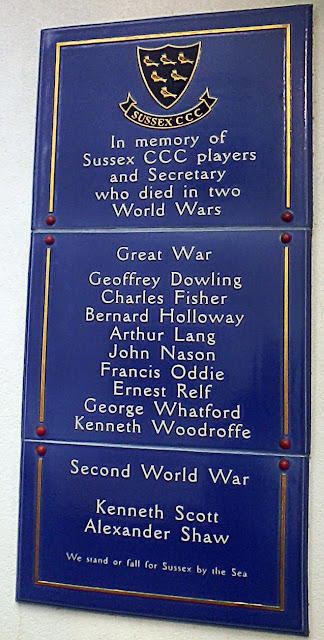 |
| copyright © D.Sharp |
Out of the nine men mentioned above, killed in the Great War, only one of them merited a mention in Hove’s Roll of Honour by virtue of being a Hove resident. He was Lieutenant Francis Arthur Joseph Oddie and he lived at 7 Bigwood Avenue. He was born at Horsham on 25 September 1879. In 1901 he married Lilian and subsequently became a journalist on the Sheffield Daily Telegraph. He was later appointed secretary to Sussex County Cricket Club. He joined the 28/Middlesex Regiment but afterwards was attached to the 2/Royal Berkshire Regiment. He was killed on 23 October 1916 near Bapaume whilst leading his platoon into action at the Battle of the Somme. His body was never recovered and his name is inscribed on the Thiepval Memorial to the Missing of the Somme.
The 1920s
In 1923 Hove Council gave permission for Tamplin’s Brewery to run a tea pavilion in the grounds. The timber-framed building stood 10 feet high to the eaves and measured 105 feet x 30 feet 8 inches. The roof was covered with a substance with the peculiar name of ‘ruberoid’. In 1925 council sanction to run it was extended for another year.
One of the characters of the county ground in the 1920s was an old man nicknamed Cushions. He used to hire out cushions at three pennies a time to spectators who found the wooden seats a trifle hard on their posterior.
An essential member of the ground staff was a horse that used to pull a roller over the grass between innings. The horse wore his own set of leather bootees in order that his horseshoes did not cut up the turf.
The 1930s
In 1930 a scoreboard facing the pavilion was erected in memory of Sir Hildebrand Aubrey Harmsworth (1872-1929). He was regarded as the most eccentric of five brothers who all became distinguished newspaper magnates and politicians, including Lord Northcliffe and Lord Rothermere. Sir H.A. Harmsworth died in April 1929 and the Rector of Hangleton and Bishop Russell Wakefield conducted his funeral. He was buried on the south side of St Helen’s churchyard, Hangleton.
On 30 June 1930 Princess Louise, Duchess of Argyll, attended a rally of one thousand Girl Guides at the County Ground. Since she was born in the year 1848, also known as the year of revolutions, her mother Queen Victoria expected her to be different. Indeed she was, being better looking than most of her siblings and of an artistic temperament. She sculpted the statue of Queen Victoria that was unveiled outside Kensington Palace in 1897.
In the 1930s the cricket ground was mortgaged to Barclays Bank to secure a loan of £5,000. The cricket club did have some alternative sources of income but they were very small. For example there was the Sussex County Tennis Club located on the east side, which up until 1931 brought in £150 a year; there were also agreements with Belmont School and Claremont School and they paid £18-15s a quarter.
The scoreboard near the secretary’s office was rebuilt and unveiled on 16 June 1934. There was also a plaque in memory of HH the Maharaja of Nawanagar (K.S. Ranjitsinhji) being the gift of A. Miller Hallett. The famous artist Eric Gill, who went to school at Hove, wrote ‘Even now, when I want to have a little quiet wallow in the thought of something wholly delightful and perfect, I think of Ranji on the County Ground of Hove.’
It is interesting to note that in the recently opened Sussex Cricket Museum several items relating to Ranji are to be found, besides the photographs and other memorabilia. For example, there are the table and set of eight chairs that Ranji used when he lived at the Norfolk Hotel, Brighton. It is said that when Ranji left England in 1920 to return to India, the hotel manager kindly rang the club to ask if they would like them as souvenirs. There is also a personal item that Ranji signed and presented to Sussex CCC. It is an album of photographs relating to his coronation in 1907 and the only other copy is in Delhi.
In 1935 it was stated that the Sussex County Cricket Ground, occupying ten acres, could seat 13,000 people including the pavilion stand at the south end.
Second World War
On 14 September 1940 while a cricket match was in progress, a bombing raid suddenly materialised. Five high-explosive bombs and one unexploded bomb fell onto the cricket ground, Salisbury Road and Grand Avenue. Nobody was killed that day but unhappily ten days later three soldiers were killed while attempting to disarm the UXB. The bombs caused four large craters in the county ground.
John Matthews, his son Tom and their father Frank were playing cricket at the time. As the bombs fell Frank Matthews was batting and he just strolled over to square leg. Cecil Somerset from Goring wanted the ground staff to fill in the holes so that the match could continue. But it was decided it would be more sensible to draw stumps. John Matthews was later shot down over Germany and by a strange coincidence he learned the Germans had intended to hit a Brighton brewery that day rather than make holes in the cricket ground.
John Connor remembered a wartime cricket match between a team of Australian Air Force personnel and a team of auxiliary firemen; former Sussex wicket-keeper ‘Tich’ Cornford captained the firemen. There were only around one hundred spectators but they were treated to some entertaining cricket including a tremendous six hit by youthful Flight Sergeant Miller, which shattered the pavilion clock. Not surprisingly, the Flight Sergeant went on to have a career in cricket and as Keith Miller he became an Australian all-rounder.
In around 1942 play was interrupted when a small bomb fell near the score box and the players threw themselves to the ground. Maurice Tate was heard to complain ‘What a nerve. Fancy bombing us!’
 |
copyright © Royal Pavilion & Museums, Brighton & Hove
The County Ground in the 1960s |
Maurice Tate Memorial Gates
On 17 May 1958 the Duke of Norfolk opened the Maurice Tate Memorial gates. Arthur Gilligan and
Sir Jack Hobbs unveiled the memorial panels. Brighton College of Arts and Crafts designed the gates, which were 16 feet 6 inches in height and over 9 feet wide. The monogram MWT and dates 1895-1956 appear in the wrought ironwork.
The Maurice Memorial gates are still at the county ground but are no longer at the entrance. They are to be found within 10 yards of the Cricket Museum.
Centenary Year 1972
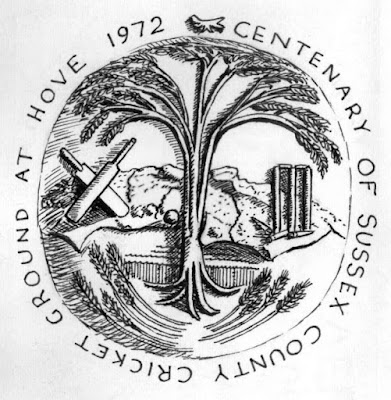 |
copyright © J.Middleton
A drawing of the centenary plaque, which is much larger than you might expect.
Note the ears of barley to signify the former use of the county ground. |
There were celebrations to mark the centenary of Sussex County Cricket Ground in 1972. On 7 June the Mayor of Hove unveiled a special plaque designed by Bernard and Anne Davis.
The old south stand dated back to the 1890s. In 1972 Arthur Gilligan, chairman of the club opened a new south stand; it was named after him. The project included an indoor cricket school.
Hubbard Ford & Partners of Hove were the designers, and McManus Marfield the suppliers. Both firms were involved in the construction of Ashdown, the L-shaped block of 125 flats in Eaton Road.
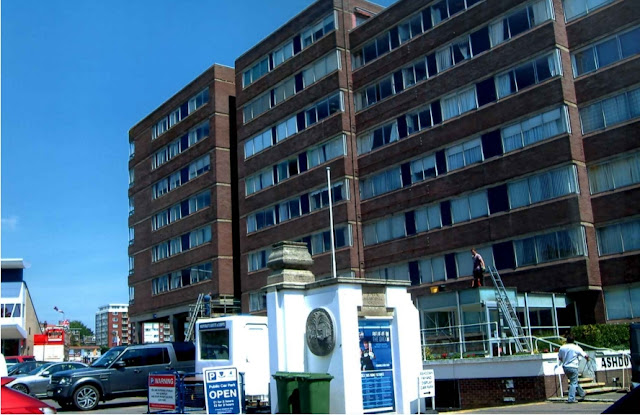 |
copyright © J.Middleton
The block of flats named Ashdown towers over the old entrance to the county ground. The centenary plaque is visible above the wheelie bins. |
Sidelights
In 1991 Peter Eaton, 49-year old head groundsman, celebrated 25 years with the club. He said he usually started preparing the pitch for the forthcoming season in February. Bare patches were sown with dwarf rye grass.
During the late 1980s and in the 1990s restrictions on female club members finally began to be eased. In 1992 ladies were even allowed into the committee room during matches – such a thing had been unheard of before.
Financial Matters (Again)
Lack of income continued to be a problem for the club. Alternative sources were sought; for example, in 1984 Firview Markets Ltd started to hold regular Friday markets at the ground.
In October 1990 an ambitious scheme was produced that would entail the construction of 122-bedroom hotel at the ground, which would also involve the loss of the pub. Naturally, the plan sparked off a wave of protests from local residents. A petition objecting to the building of the hotel carried 43 signatures and was submitted to the council, which also received 36 individual letters against the scheme.
Members of Hove Council Planning Committee stated they had reservations concerning the size of the building, the colour of materials and car parking facilities. But there were other people who supported the club’s endeavour. In the end nothing came of the plans.
In July 1994 plans were unveiled for a £5 million development; they included a new pavilion and multi-purpose leisure centre on the north side and more hospitality suites on the east side. The deck chair area for members would be re-sited on a smaller scale near the Gilligan stand. It was hoped to raise £1.3 million towards the project by letting Cricketers pub on a long lease together with the parcel of land that went with it.
The Planning Committee of Hove Council approved the plans in November 1994, albeit with some changes. But residents of Hovedene, a large block of flats in Cromwell Road, objected strongly to the proposals with one of their number firing off an angry letter to the Prime Minister. The Hovedene residents said the new building would block their views and be a blot on the landscape. But as one witty letter-writer put it, as far as he could see from the architect’s drawings, the only blot on the landscape was Hovedene.
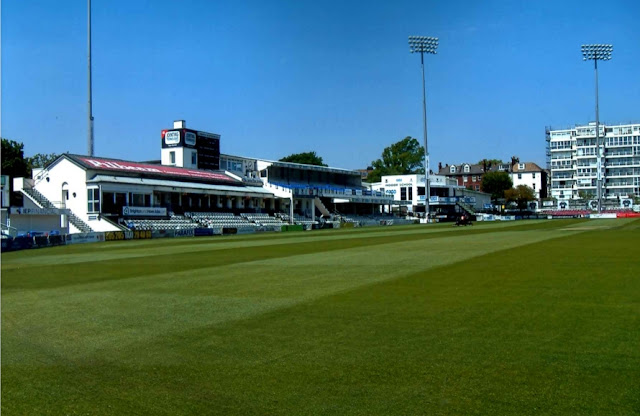 |
copyright © J.Middleton
The Sussex County Cricket Ground was photographed on 11 June 2015 with the turf looking in immaculate condition because it had just been mown. The block of flats called Hovedene can be seen on the right. |
Bernard Jordan, leader of Hove Council, upset the sensibilities of the club by saying the development was unnecessary because Sussex was not in the top league of English cricket clubs. (This was the same Bernard Jordan who in 2014 caused a national sensation by sneaking out of the his care home at Hove with his war medals concealed under his coat in order to attend the D-Day commemoration in Normandy. Newspapers loved the story, which was dubbed ‘The Great Escape’. When he returned home, he was treated as a hero and there were many stories, photographs and interviews in the newspapers).
Nigel Bett, club secretary, rushed to its defence, asserting Sussex was one of only eighteen playing first-class cricket and it had the eleventh highest number of members. Sussex had won the four one-day trophies four times and in 1994 finished eighth in the County Championships. Ironically, just nine years later Sussex would enter what cricket aficionados call The Golden Decade when Sussex really were top of the pops.
Eggcup Saga
Stonegate, the Hailsham-based egg supply company, was a sponsor of the county ground. In order to draw attention to their generosity, they devised the famous eggcups raised up high on pylons. The plastic eggcups were blue and came complete with natural coloured eggs. It was not long before Hove residents weighed in, labelling the eggcups as hideous in May 1998.
In July 2000 it was stated the eggcups would have to come down. In fact, Stonegate were surprised to hear they were still in place and they were also considering pulling out of their sponsorship.
A Possible Move away from Hove?
In the 1990s the club was beginning to grow increasingly frustrated with the constant battle to increase its finances by staging money making ventures, only to be stumped at every turn by planners and residents. But the fact remains the cricket ground had been here decades before the blocks of flats were erected, and indeed most of the housing in the vicinity too. As another letter-writer put it, would residents really prefer a giant superstore to be built on the site?
In fact in 1998 the club were seriously considering moving away from Hove. In March 1998 one suggestion was for a new cricket ground at Falmer next door to Sussex University. The idea was not restricted to cricket either, as it envisaged new grounds for football and greyhounds too.
Also in March 1998 the committee of Sussex County Cricket Club met behind closed doors and came to a decision the club must move. Robin Marlar, outgoing chairman, said, ‘The committee is united in its wish to see us in a new home. Sport now needs stadia, not a homely little ground surrounded by flats.’
The committee members were perhaps being over optimistic about their prospects. What seemed to be a simple answer to their problem turned out to be a far more complex issue than was envisaged. It was not that they dragged their feet over the matter because six or seven sites had been identified in Sussex and evaluated; there had been meetings and discussions with local authorities and developers but without success. Indeed, in March 2000 chairman Don Trangmar was obliged to announce that Sussex County Cricket Club would not be moving from Hove in the foreseeable future.
Floodlights
 |
copyright © J.Middleton
This view emphasises just how tall the controversial floodlights are. |
In 1998 there was some controversy about floodlights, which the club usually hired for specific games. But it cost £30,000 to hire such lights for each game and it would make economic sense to install their own. Naturally, nearby residents were up in arms. But on 15 September 1998 the Planning Committee voted 8-2 in favour of installing eight floodlights. There were restrictions attached of course; the lights must not be used for more than twenty days in the year and they must be switched off by 11 p.m. By April 1999 the last of the 30-foot pylons was erected. It made Sussex the first club in the northern hemisphere to have such floodlights.
On 1 April 1999 there was an Open Day at the county ground culminating in a day/night friendly match in front of 3,000 spectators. As it was the club’s first match under the new floodlights, it is pleasant to record that it was also a special time for new overseas star Michael Di Venuto who scored a century.
In February 2000 it was revealed that only £4,000 had gone towards the cost of the £160,000 floodlights. Although the club recorded a surplus of just over £9,000 the games staged at Arundel, Horsham and Eastbourne resulted in a deficit of £7,657.
On 17 May 2000 the first floodlit game of the season took place. But neighbours were infuriated when the lights stayed on until after midnight in order to allow Sky TV to remove their giant screen safely.
The first women’s day/night match was held on 30 August 2000.
The Willows
In December 2000 it was stated the cricket club already had planning permission from 1994 for a £6 million scheme to build a new pavilion at the north end. It was almost certain the old Gilligan stand would have to go and there would be a new one to replace it.
In the summer of 2001 work started on the Willows building situated at the north west corner of the ground to build a new cricket school. This involved the demolition of the old squash club. But the project also meant the memorial garden to George Cox had to be removed, which upset some people. George Cox played for the Sussex County Cricket team from 1931 to 1960 and scored 50 centuries during his career.
Hugh Griffiths, operations manager, said it was important to make provision for young cricketers because the present two-lane facility was probably the worst in county cricket.
On 17 January 2003 the new cricket school costing £850,000 was officially opened. President-elect Jim Parks and skipper Chris Adams cut the ribbon. There were four 16-metre and one 22-metre practice lanes downstairs while on the first floor there was a bar and viewing area plus players’ dressing rooms.
The club very much hoped the new venue would attract business use. The club were in line to be awarded Lottery money but news of a windfall leaked out and the money was refused. Instead, the club was obliged to take out a mortgage of £300,000 to help pay for the school.
Spen Cama
Spen Cama died in May 2001 at the grand age of 95, leaving a fortune of £23 million. He was an ardent cricket enthusiast and during the Second World War when there were few professional cricketers available he played cricket for Sussex; he was also a hugely successful businessman. In his youth Mr Cama founded Preston Nomads Cricket Club in 1927, provided them with a pavilion and ground and left them £4 million in his will. He left Sussex County Cricket Club £7 million. At the club’s AGM in March 2003 chairman David Green stated the £7 million was a ‘conservative estimate’ and the final figure could be more, or less. But he was pleased to announce that the future of Sussex County Cricket Club was secure.
Quite simply, Spen Cama’s legacy rescued Sussex County Cricket Club from financial insecurity. The club was able to go ahead with a £11 million ground development scheme, the second phase of which was completed by April 2011. In September 2011 the newly refurbished pavilion was officially re-named the Spen Cama Pavilion and a bust of the great man himself was put in a place of honour. Nick Bremer created the bust and it is an excellent likeness.
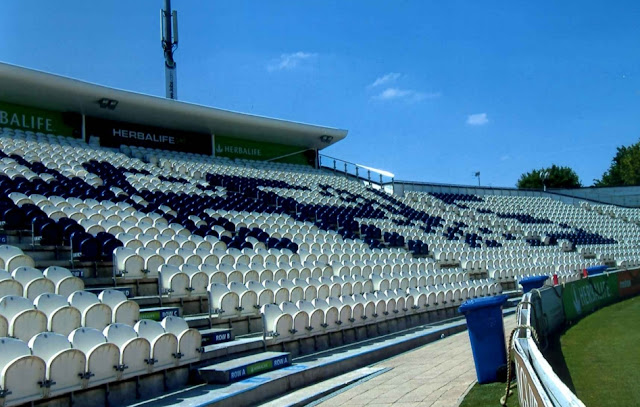 |
copyright © J.Middleton
These two views are in a way a tribute to Spen Cama because if it had not been for his generosity Sussex CCC would never have been able to afford all these modern improvements. |
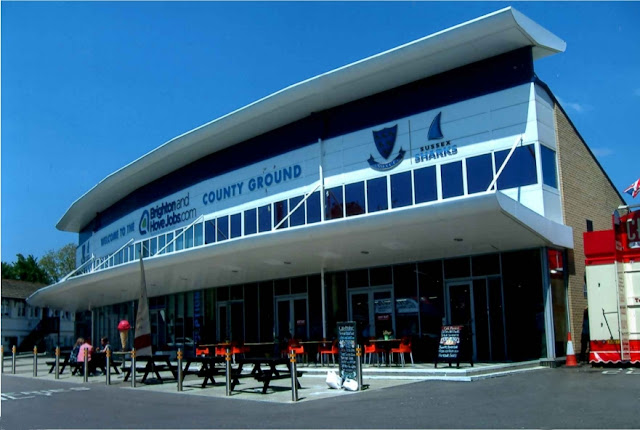 |
| copyright © J.Middleton |
Sussex Cricket World Museum
It is not surprising that a club with such a long history as Sussex should accumulate all sorts on interesting memorabilia over the years. But the storage was haphazard, items were not properly catalogued and the public at large was unaware of the treasures hidden from sight.
Sussex County Cricket Club decided to remedy the situation in 2009 by forming a charitable trust known as the Sussex Cricket Museum & Educational Trust, which would be responsible for all the items. The ultimate aim was to create a museum displaying items from the collection for the public to enjoy.
But before that could happen, there were hours and hours of work to be put in, to sort, identify, catalogue and arrange the items. Fortunately, there was a happy band of enthusiastic volunteers and keen supporters who were more than willing to take on the task (unpaid).
On 5 May 2012 Matt Prior opened the Sussex Cricket Museum, which is situated under the Spen Cama pavilion.
Robin Marlar, Sussex cricketer, generously decided he wanted to give back something to the game he had enjoyed so much and therefore decided to send his large cricket collection for auction, with the profits going towards the museum.
The auction was held on Saturday 11 April 2015 and Robin Marlar’s collection went under the hammer in 434 separate lots. Charlie Ross of well-known televisions programmes Bargain Hunt and Flog it! was the auctioneer in charge of the proceedings; he added greatly to the occasion, cajoling the public and wielding his hammer during six long hours without taking a coffee break.
There was enormous interest in this fine collection of cricket memorabilia and at the start of the auction 80 bidders had registered while around the world some 120 enthusiasts were prepared to bid online. Some winning bids were fielded from Australia, Germany, India, Portugal, United States of America, and of course from all over the United Kingdom. There was also an eminent dealer on the phone from Mallorca.
Altogether, it was an exciting auction that raised just over £166,000 and the Museum befitted by some £40,000.
It is pleasant to report that the cricket museum was able to purchase at this auction Corbet Anderson lithographs of our famous local heroes, the four Lillywhites. Frederick Lillywhite (1829-1866) James Lillywhite (1825-1882) and John Lillywhite (1826-1874) were all born at Hove.
The cricket museum has also published six booklets on cricket and cricketers with the profits being donated to the museum. Their last effort published in 2014 was a truly magnificent large format volume crammed full of wonderful photographs, portraits, memorabilia and scorecards, which quickly sold out.
Hope for the Future
It hardly need
stating that the year 2020 – the year of Covid-19 – was an
extremely difficult time for all sport, and perhaps especially
cricket, and even the few matches that did take place produced
disappointing results. However, at last things are beginning to move
on the re-development front with the start of the £20 million
scheme, which will help cricket to stay on the Hove site in the
future, besides replenishing the coffers. As Rob Andrew, chief
executive of Sussex Cricket, pointed out, cricket has been played
here for 150 years and it is sincerely hoped that a firm footing will
now be forthcoming for the next 150 years. But it will not be a quick
solution, and the master plan could take at least seven years to
complete. In September 2020 the first steps were being taken towards
constructing the 137 flats at the south-west corner of the ground,
formerly occupied by the Sussex Cricketer pub.
Roffey Homes describe the flats as ‘a beautifully crafted
collection’. (Argus
26/9/20)
Sources
Argus
J.Middleton Encyclopaedia of Hove and Portslade
Gaston, A.J. Sussex County Cricket Club (1924)
Lee, Christopher From the Sea End (1989)
Hove Council Minutes
Pictorial History of the Sussex County Cricket Club. Editors R. Packham, N. Sharp, P. Barnes, J. Filby (2014)
Sussex CCC Arundel Festival of Cricket 2015
The Keep
ACC/ 5369/14 Sussex County Cricket Ground 1885
Internet
To read the transcript of the interview with Jon Filby, Vice Chairman of Sussex County Cricket Club and Secretary of the Sussex Cricket Museum Educational Trust please click on this '
Cricket-Country website Link (retrieved from the internet 29/6/2015)
Thanks
To Roger Packham for checking the text for howlers, and for providing additional information.
To Nicholas Sharp, an avid fan of SCCC since the year dot, for some interesting details
To Robert Jeeves of Step Back in Time, 125 Queens Road, Brighton, BN1 3WB. for allowing the reproduction of two splendid old photographs
To Brighton and Hove City Libraries for allowing the reproduction of the evocative photo of Lieutenant Oddie
Copyright © J.Middleton 2015
design by D.Sharp











